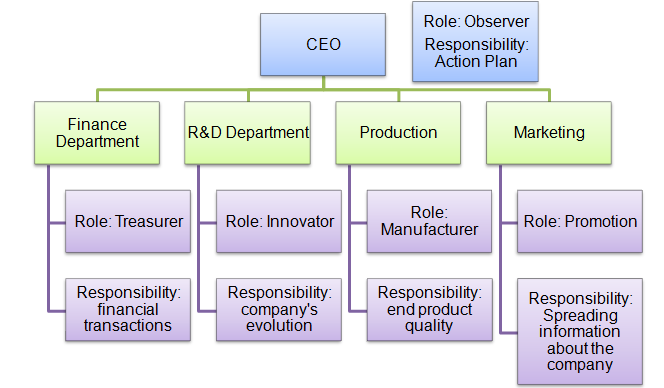Defining a structure of an organization is not an easy task, since it involves a thorough analysis of the company’s goals, mission and vision, as well as careful consideration of the roles and responsibilities that the company members are going to take within the given structure.
Because of the focus of the Mobile Headset Company, as well as the fact that the company consists of comparatively few people, it will be most reasonable to adopt the Functional Structure (Daft, 2010) and make sure that the chosen structure should provide the best opportunities for information management and contribute to an efficient knowledge sharing process.
The choice of the Functional Structure Model as the basis for the organizational structure was predetermined by the fact that the given model allows for a reasonable distribution of roles and responsibilities to each of the company members, as well as defining the tasks that each department is supposed to accomplish.
Therefore, the Functional Structure model helps solve one of the basic problems haunting large companies, i.e., the means to introduce cohesion and cooperation into the work of different departments within a company.
To start with, the delegation of responsibilities within the company in question is going to be carried out in the following manner:
Table 1. Roles and Responsibilities of the Company Members

One of the key peculiarities of the structure provided above is that the delegation of responsibilities is strictly hierarchical, i.e., the corresponding tasks can be assignment to a corresponding staff member of a department by a superior staff member or a department; however, the given rule presupposes that the task cannot be assigned to a Discount Manager by the CEO of the company; instead, the Finance Department manager is supposed to handle the given task.
Therefore, the suggested system admittedly lacks flexibility (Daft & Lane, 2009).
Despite the lack of opportunities for fast adjustment and flexibility in delegating responsibilities, the Functional Structure Model allow for a very peculiar role distribution.
Seeing how the given model presupposes that the company should have a clear action plan and a list of responsibilities for each department, it is reasonable to assume that the company managers may possibly switch roles when needed.
Therefore, the system in question is going to be of great significance for the given company, since it will provide the environment for the company’s evolution.
As the picture provided above shows, the CEO is going to be responsible for both designing the action plan and making sure that the plan is followed. The CEO’s role, however, will concern not only designing the action plan, but also coming up with the strategies for efficient leadership.
The finance department will play the role of a treasurer and be responsible for the company’s financial transactions, as well as its pricing policy. R&D Department will play the role of an innovator and be responsible for the company’s growth.
The Production Department will be in charge of the end product quality and the actual production process, playing the role of an artisan and a manufacturer at the same time. Finally, the Marketing Department plays the part of the company’s agent and is responsible for the company’s popularity and its brand names recognition.
The rationale behind the structure chosen for the Mobile Headset Company is, therefore, predetermined by the necessity to provide maximum efficacy in information management, especially the process of data acquisition.
Because of relatively high competition rates, it is crucial for the company to make sure that it acquires the necessary information faster than the rest of the companies and uses it for its benefit. With the introduction of direct delegation between the representatives of different departments, knowledge sharing principles, as well as faster information acquisition will become possible.
Reference List
Daft, R. L. & Lane, P. (2009). Management. Mason, OH: South-Western Cengage Learning.
Daft, R. L. (2010). Organization theory and design. Mason, OH: South-Western Cengage Learning.